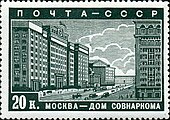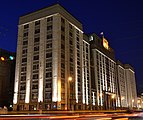Building of Council of Labor and Defense
| Building of Council of Labor and Defense | |
|---|---|
 | |
 | |
| General information | |
| Location | Tverskoy District, Moscow, Russia |
| Address | 1 Okhotny Ryad |
| Coordinates | 55°45′28″N 37°36′57″E / 55.75778°N 37.61583°E |
| Current tenants | State Duma of the Russian Federation |
| Construction started | 1932 |
| Opened | 1935 |
| Design and construction | |
| Architect(s) | Arkady Langman |
| Website | |
| duma.gov.ru | |
The building of Council of Labor and Defense (Russian: Здание Совета труда и обороны, romanized: Zdaniye Soveta truda i oborony) is a state building located on Okhotny Ryad Street in central Moscow, Russia, 250 meters north of the Kremlin. Since 1994 it has served as the meeting place of the State Duma, the lower house of the Russian parliament. It is alternatively known as State Duma building (Russian: Здание Государственной думы) or the Okhotny Ryad building (Russian: здание на Охотном Ряду). It has a regional-level cultural heritage status.[1]
History
[edit]The idea of erecting a large representative building near the House of Unions arose in the mid-1920s. In 1926, a competition was held for the design of the building for the State Bank of the USSR, however, construction on this site was also abandoned and the old Bank building on Neglinnaya Street was reconstructed according to the project of Ivan Zholtovsky. In the early 1930s, simultaneously with the competition for the Mossovet hotel, a competition was announced for the project of the Hotel Intourist on the other side of the street, but soon this project was abandoned and the Soviet authorities decided to build an office building for the Council of Labor and Defense on the site.[2]
To clear a place for the building, despite the objections of art critics, the restored Church of Paraskeva Pyatnitsa and the Golitsyn Chambers of the 17th century were demolished, while the nearby Troyekurov Chambers survived.[3] Without announcing a competition, the design was entrusted to the architect Arkady Yakovlevich Langman, who completed it with the participation of architects S. Sergiyevsky and N. Meziere. By that time, Langman already had experience in the construction of large structures in Moscow: the Dynamo stadium (together with Lazar Cherikover) and the House of the Dynamo society (together with Ivan Fomin).[2]
Langman coordinated the height parameters of the building with the Mossovet hotl — nearly the same height of both buildings was supposed to conceal the large relief difference from Lubyanskaya to Manezhnaya squares and create the illusion of straightness of the front street, running to the new architectural dominant of Moscow - the Palace of the Soviets.[2] Nikita Khrushchev, then head of the city, recalled how the architects discussed the project with the future "owner" of the building Vyacheslav Molotov (chairman of the Labor and Defense Council). Ivan Zholtovsky said that the project is acceptable, but not expressive, and to prove his words, he turned the picture upside down: "Can it be built like this? It is possible, it will not lose anything aesthetically, and no one will notice".[4]
The building of Council of Labor and Defense was built in 1932–35, however, Langman's plan was not fully implemented. According to the initial project, the uniformly designed corps were supposed to form a square and to include the House of the Unions. Criticism from the chief architect of Moscow Sergey Chernyshyov forced to abandon these plans.[2]
Ownership
[edit]
In April 1937, two years after the completion of the building, the Council of Labor and Defense was dissolved. In this year's guide to Moscow, the building is listed as the House of the Council of People's Commissars of the USSR. Later, the building belonged to the Council of Ministers of the USSR, and finally to the State Planning Committee.[3] From 1994, the State Duma of the Russian Federation has been working in the building.
In the early 2010s it was planned that after the construction of a new parliamentary center in Mnyovniki, the State Duma building would be demolished to build a hotel or a shopping center in its place. Such plans were announced by businessman Mikhail Gutseriyev.[5]
Overview
[edit]The building plan is symmetrical. The long main and narrow side facades are decorated with high fluted pilasters. The main facade is dissected by two side and central projections. In the central risalit there is a flat entrance portico, which is close in proportion to the columnar portico of the House of the Unions standing nearby. On the front plane of the attic there is a state emblem of the Soviet Union, and on the roof there is a flagpole with the flag of Russia. Stylistically, the design of the State Duma building combines both elements of constructivism, as well as monumentality and representativeness — features inherent to the next period of the Soviet architecture.[3]
By the beginning of the exterior decoration, the deposits of marble-like limestone near Kolomna, turned out to be exhausted, and slabs removed from the Cathedral of Christ the Savior, demolished in 1931, were used instead. The granular plaster covering the internal facade is made of stone chips, which were obtained by grinding marble facings of Moscow churches massively demolished in the 1930s. The same materials were used to decorate the Okhotny Ryad metro station being built at that time, one of the exits of which was originally planned to be placed inside the Building.[2] The three entrance arches are made of labradorite and Karelian granite.
Gallery
[edit]-
State emblem of the USSR and Russian national flag
-
1939 Soviet stamp: "Sovnarkom building"
-
1947 Soviet stamp: "Council of Ministers house and Moskva Hotel"
-
Demonstration for impeachment of Boris Yeltsin, May 1999
-
State Duma building at night
References
[edit]- ^ "Здание Совета Труда и Обороны, 1932—1936 гг., архитектор А. Я. Лангман" (in Russian). Department of Cultural Heritage of the City of Moscow. Archived from the original on 2021-10-04. Retrieved 2020-02-17.
- ^ a b c d e Bronovitskaya, Natalia (2015). Архитектура Москвы 1933—1941 гг [Architecture of Moscow 1933–1941]. Architectural monuments of Moscow (in Russian). Искусство—XXI век [Art — 21st century]. ISBN 978-5-98051-121-0.
- ^ a b c Tatyana Vorontsova. "Здание Совета Труда и Обороны" [Building of Council of Labor and Defense] (in Russian). Узнай Москву. Retrieved 2015-04-30.
- ^ N. Khrushchev (redacted by A. Shevelenko) (2007). Никита Хрущёв. Воспоминания: избранные фрагменты [Nikita Khrushchev. Memories: Selected Fragments] (in Russian). Vagrius. ISBN 978-5-9697-0517-3.
- ^ ""Архнадзор" выступал против сноса здания Госдумы после передачи Гуцериеву" [ArchNadzor opposed the demolition of the State Duma building after its transfer to Gutseriyev] (in Russian). RBC.





